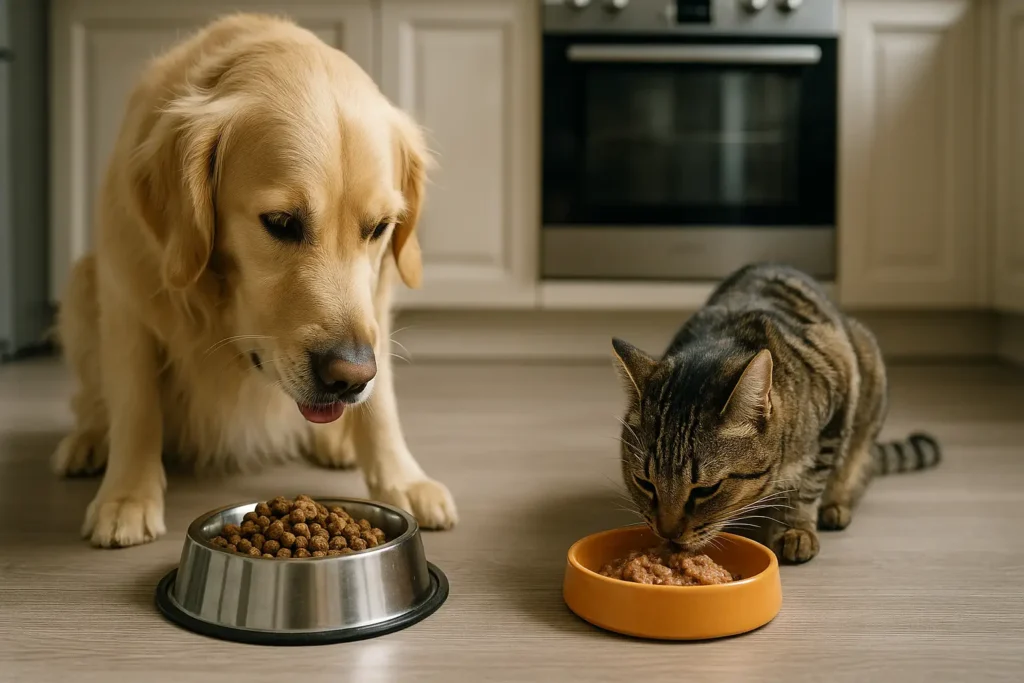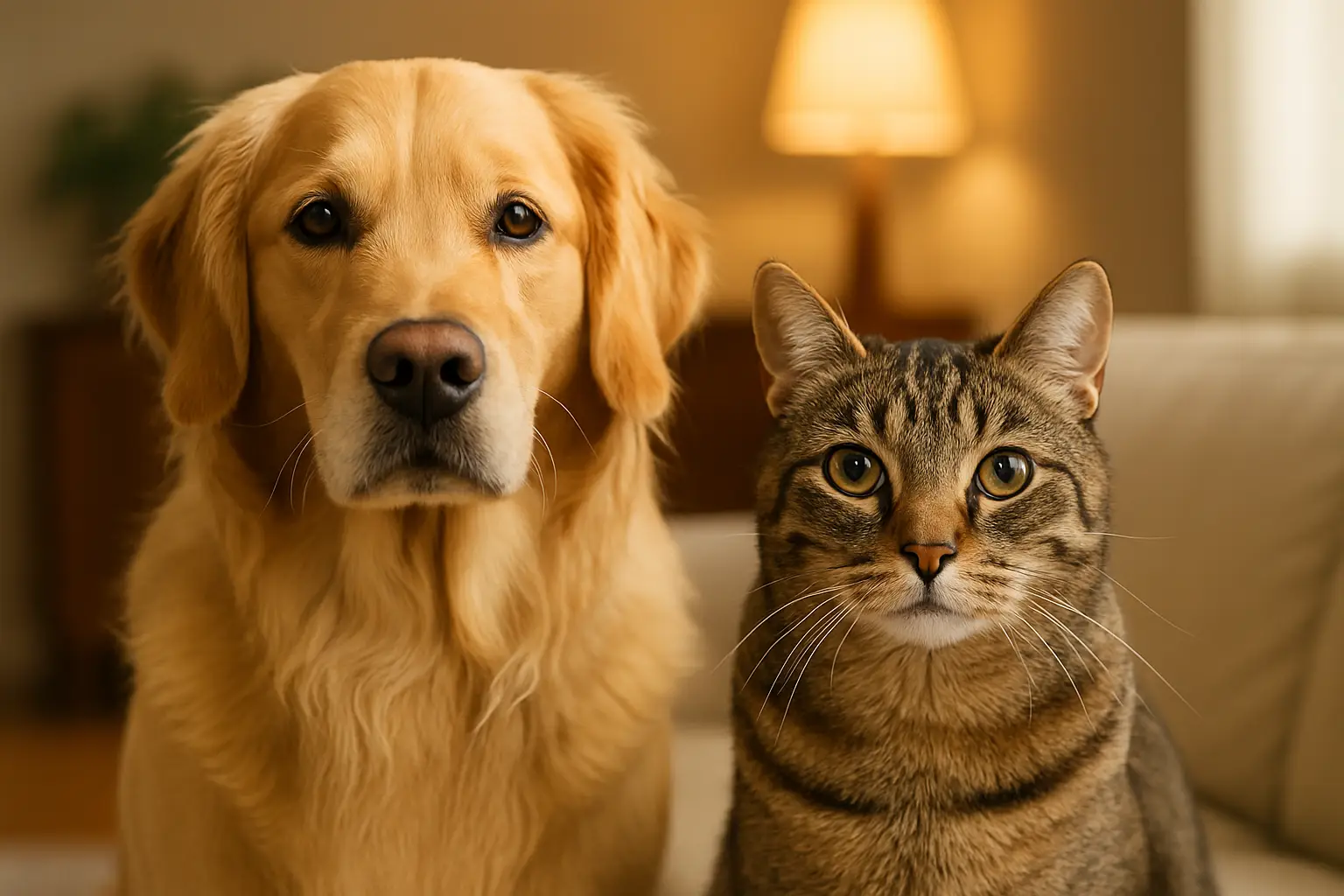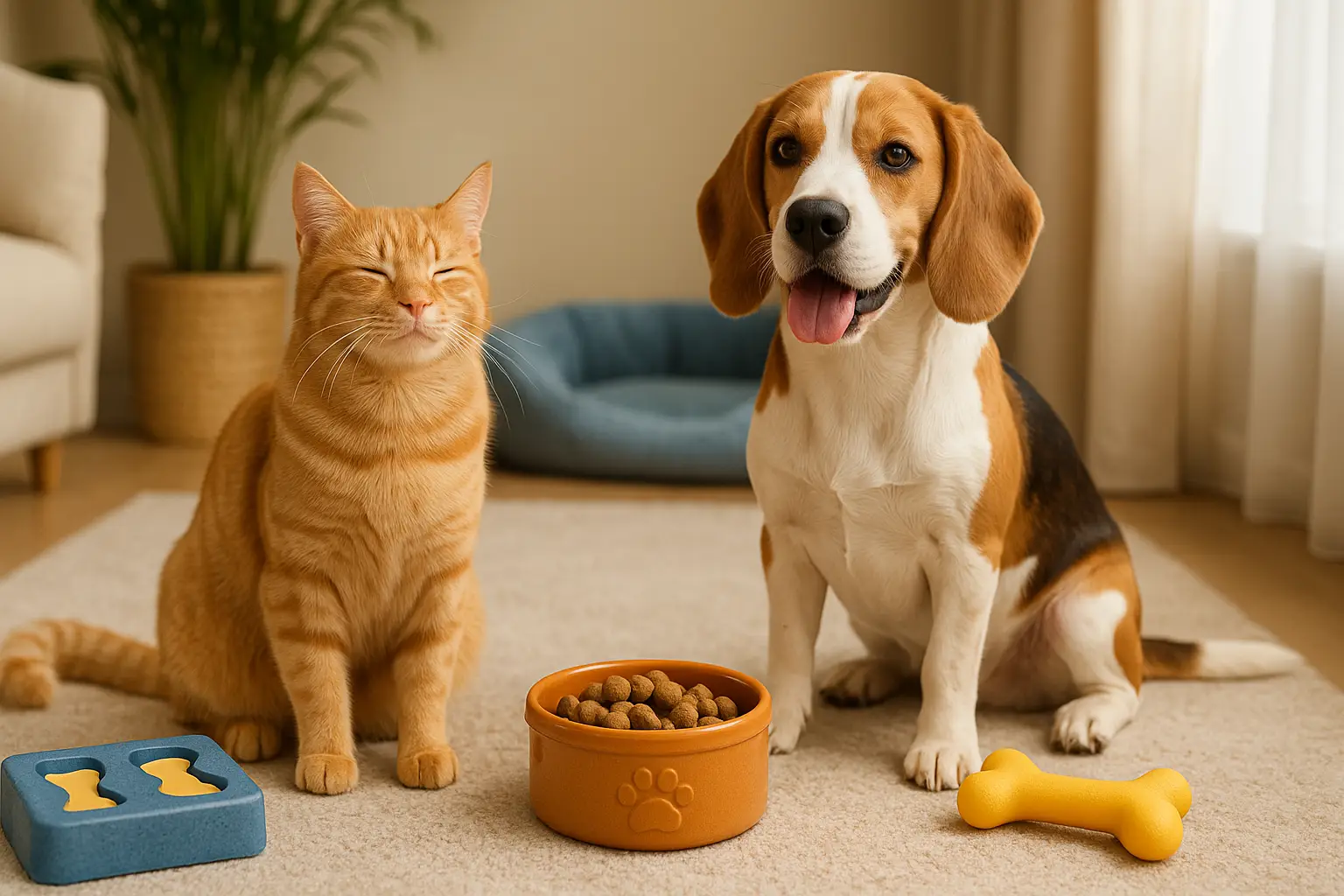How to Create a Balanced Meal Routine for Your Dog or Cat
Feeding your pet is more than just placing food in a bowl—it’s an opportunity to improve their health, reinforce good habits, and deepen your bond. A consistent, balanced meal routine for pets can reduce behavioral issues, support digestion, prevent weight gain, and make daily care easier.
Whether you’re a new pet parent or refining your current approach, this guide will help you design a customized meal routine for your dog or cat that fits your lifestyle and meets their nutritional and emotional needs.

Why Meal Routines Matter for Pets
Unlike wild animals who hunt or scavenge unpredictably, domestic pets thrive on structure. A reliable meal schedule isn’t just convenient for you—it gives your pet a sense of stability and comfort.
Benefits of a Regular Meal Routine for Pets:
- Promotes healthy digestion and metabolism
- Helps manage weight and portion control
- Improves toilet training and regular bathroom habits
- Reduces food-related anxiety or aggression
- Builds anticipation and structure into your pet’s day
- Makes it easier to detect health problems (e.g., appetite loss)
Creating a meal routine also allows you to control food freshness, eliminate overeating, and avoid begging behaviors.
Understand Your Pet’s Nutritional Needs
Every animal is different. Your dog or cat’s size, age, breed, and health status will determine the best type and amount of food.
Dogs:
- Puppies (under 6 months): 3–4 meals/day
- Adult dogs (1–7 years): 2 meals/day
- Senior dogs (7+ years): 2–3 smaller meals/day
Cats:
- Kittens (under 6 months): 3–4 meals/day
- Adult cats (1–7 years): 2–3 meals/day (or free-fed with portion control)
- Senior cats: 2 meals/day with high-quality protein and easy digestion
Always consult your vet to tailor your feeding plan, especially if your pet has allergies, weight issues, or chronic conditions.
Step 1: Choose the Right Feeding Method
There are three main methods for feeding pets. Each has pros and cons depending on your schedule and your pet’s habits.
1. Scheduled Feeding (Recommended)
- Serve food at set times
- Remove bowl after 15–30 minutes
- Helps regulate appetite and behavior
2. Free Feeding (Cats Only, with portion control)
- Leave food out all day
- Monitor intake carefully
- Risk of overfeeding if not portioned
3. Portion-Controlled Feeding
- Measure exact servings
- Ideal for weight management
- Works with both scheduled and free feeding
💡 Best practice: Use scheduled, portion-controlled feeding for most pets. It builds routine and prevents overeating.
Step 2: Establish Meal Times
Most pets thrive with meals 10–12 hours apart. Choose times that align with your household’s rhythm.
Sample for dogs:
- 7:30 AM – Breakfast
- 6:30 PM – Dinner
Sample for cats:
- 7:00 AM – Breakfast
- 12:00 PM – Snack or wet food (optional)
- 6:00 PM – Dinner
Keep meal times consistent. Pets will start to anticipate feeding, which also encourages good behavior.
Step 3: Select High-Quality Food
Choose commercial or homemade food that fits your pet’s age, size, and health.
Key features of high-quality food:
- Real protein as the first ingredient (chicken, turkey, beef, fish)
- No fillers like corn, wheat, or by-products
- Balanced nutrients: protein, fat, fiber, vitamins
- AAFCO-approved labels (for U.S. products)
Ask your vet if a grain-free, limited ingredient, or prescription diet is appropriate for your pet.
Step 4: Control Portions Accurately
Overfeeding is one of the most common causes of pet obesity. Use these steps to manage portions:
- Read the feeding chart on the food label
- Adjust based on weight, age, and activity level
- Use a measuring cup or digital kitchen scale
- Monitor treats—keep them under 10% of total daily calories
For example:
- A 10 kg (22 lb) dog may need 1.5–2 cups of food/day
- An 8 lb cat may need about 1/2 to 3/4 cup (dry) or 1 can of wet food/day
Step 5: Use Feeding Tools Wisely
Modern feeding accessories can make mealtime healthier and more engaging.
Useful tools:
- Elevated bowls: Help digestion and posture
- Slow feeders: Prevent gulping and bloat (especially in dogs)
- Automatic feeders: Useful for cats or if you’re not home
- Puzzle feeders: Combine enrichment with feeding
These tools encourage pets to eat slower and use their brain while feeding.
Step 6: Incorporate Feeding into Enrichment
Turn meals into meaningful mental and physical activities.
Dogs:
- Use KONGs, snuffle mats, or scatter food on the floor
- Practice obedience cues before feeding (sit, stay, wait)
- Hide kibble around the room for a mini scavenger hunt
Cats:
- Use treat balls, puzzle toys, or hunting feeders
- Move bowls daily to encourage foraging behavior
- Divide meals across several small dishes or areas
Enrichment feeding supports your pet’s instincts and reduces boredom.
Step 7: Hydration Is Non-Negotiable
Fresh, clean water should always be available.
Tips:
- Refill water bowls at least twice a day
- Clean the bowl daily to prevent slime or bacteria
- Use ceramic or stainless steel (not plastic)
- Consider a pet water fountain to encourage cats to drink more
Dehydration can lead to urinary tract issues and kidney stress—especially in cats.
Step 8: Limit Human Food and Table Scraps
Even small scraps can lead to health problems.
Common toxic foods:
- Chocolate
- Onions and garlic
- Grapes and raisins
- Xylitol (in sugar-free gum)
- Fatty or spicy food
Only offer pet-safe fruits, veggies, or lean meats in moderation—and count them toward daily calories.
Step 9: Monitor Your Pet’s Weight and Health
Track changes to ensure the routine is working.
- Feel your pet’s ribs: You should feel them easily, but not see them.
- Check the waist: There should be a visible tuck.
- Weigh monthly or as advised by your vet
- Monitor stool quality, appetite, and behavior
Sudden changes in appetite or weight require professional evaluation.
Step 10: Plan for Treats Without Overdoing It
Treats are powerful training tools—but they should be part of the plan.
- Limit to 10% of daily calories
- Use small, low-calorie treats
- Break large treats into tiny pieces
💡 Try healthy alternatives:
- Apple slices (no seeds)
- Baby carrots
- Green beans
- Freeze-dried meat
You can also use kibble from your pet’s daily portion as training rewards.
Feeding Routine for Puppies and Kittens
Young animals need more frequent meals.
Puppies:
- 8–12 weeks: 4 meals/day
- 3–6 months: 3 meals/day
- 6–12 months: 2 meals/day
Kittens:
- 8–16 weeks: 4 meals/day
- 4–6 months: 3 meals/day
- 6+ months: 2–3 meals/day
Use high-quality food labeled for growth and development. Offer plenty of water and monitor closely for growth.
Feeding Routine for Senior Pets
Older pets often need:
- Smaller, more frequent meals
- Softer or easily digestible food
- Higher moisture content (wet food helps hydration)
- Joint support supplements (glucosamine, omega-3)
Consult your vet for the best plan if your pet has arthritis, kidney concerns, or dental issues.
How to Transition to a New Meal Routine
Making changes slowly helps avoid digestive upset and behavioral confusion.
Transition tips:
- Mix new food with old over 7–10 days
- Gradually shift feeding times by 15 minutes/day
- Keep calm, quiet environments during meals
- Use the same bowl, mat, and location for consistency
Avoid free-feeding during the transition. Structure supports adjustment.
Example Meal Routine: Adult Dog
| Time | Activity |
|---|---|
| 7:00 AM | Bathroom break and breakfast |
| 12:00 PM | Light snack (optional) |
| 6:00 PM | Dinner |
| 8:30 PM | Short walk and final potty |
Example Meal Routine: Adult Cat
| Time | Activity |
|---|---|
| 7:30 AM | Wet food breakfast |
| 12:00 PM | Dry kibble in a puzzle feeder |
| 6:00 PM | Wet or mixed dinner |
Add window perch time or play after each meal to mimic natural hunting behavior.
Final Thoughts: Structure Leads to Health
Your dog or cat depends on you not only for food, but for how that food supports their life. A well-designed meal routine for pets builds trust, improves health, and turns daily feeding into a ritual of care.
By investing in consistency, quality food, and thoughtful timing, you can reduce stress, prevent illness, and ensure your pet feels safe, nourished, and loved—day after day.




Post Comment